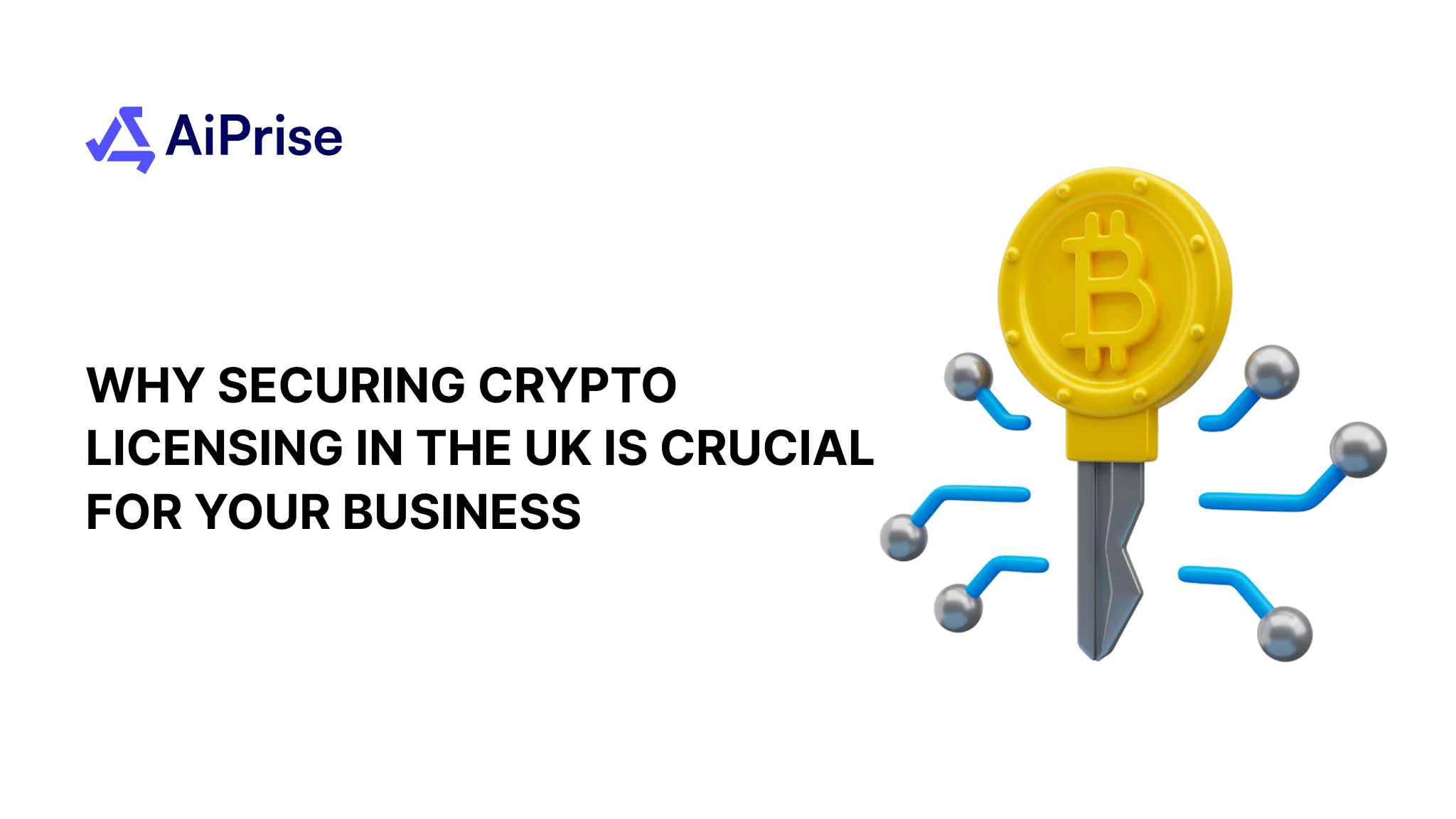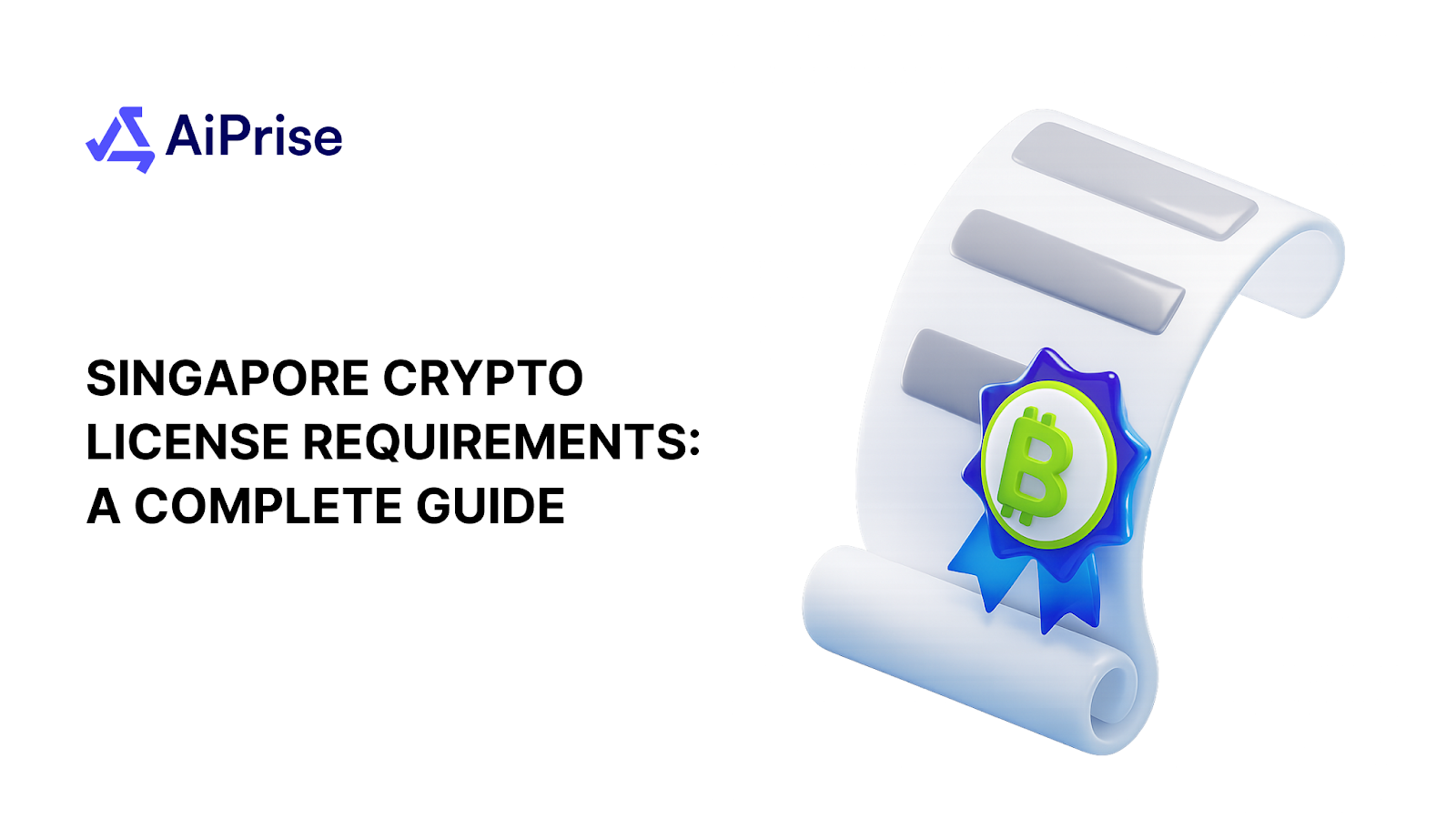AiPrise
10 min read
September 29, 2025
Importance of KYC and AML for Crypto Exchanges

Key Takeaways










Crypto exchanges rely on KYC and AML to prevent fraud, comply with regulations, and build trust with users. Yet, balancing compliance with the promise of fast, anonymous transactions remains a significant challenge. Traders expect speed and privacy, while regulators demand strict identity checks and monitoring.
This tension leaves crypto platforms caught in the middle, making it essential to understand the importance of KYC and AML for crypto exchanges. In this blog, you’ll explore why these measures matter, how they’ve evolved, and how AI-driven solutions can simplify compliance without sacrificing user experience.
Key Takeaways
- KYC and AML are critical for crypto exchanges to combat fraud, money laundering, and regulatory risks.
- Global regulators are tightening oversight, and non-compliance can result in heavy fines, license suspensions, or complete shutdowns.
- Balancing user privacy and speed with strict compliance remains one of the most challenging tasks for crypto platforms.
- AI and machine learning enable faster identity verification, real-time fraud detection, and seamless monitoring at scale.
- Choosing modern compliance solutions like AiPrise ensures exchanges can meet regulations, build user trust, and expand globally without friction.
Before diving into the details of why compliance matters, it’s essential first to understand what KYC and AML entail in the context of crypto exchanges.
What Is KYC and AML in Crypto?
KYC (Know Your Customer) and AML (Anti-Money Laundering) are critical pillars for crypto exchange compliance and security. These measures verify user identities, monitor transactions, and prevent financial crimes such as fraud, money laundering, and terrorist financing.
Implementing strong KYC and AML procedures not only ensures regulatory compliance but also builds trust, protects investors, and maintains the platform’s credibility.
Here’s how both concepts apply in crypto:
- KYC in Crypto: Involves verifying a user’s identity by collecting personal data and validating documents such as passports, driver’s licenses, or national IDs. Some exchanges also require proof of address and selfie verification to reduce impersonation and synthetic identity risks.
- AML in Crypto: Goes beyond onboarding and includes monitoring ongoing transactions to detect unusual patterns, large transfers, or suspicious wallet activities. Exchanges must also screen users against global watchlists and report suspicious transactions to regulators.
Also Read: How Identity Verification Enhances KYC Compliance
With a clear understanding of KYC and AML, let’s explore why these processes are crucial for the safety, compliance, and growth of crypto exchanges.
Why KYC and AML Matter for Crypto Exchanges
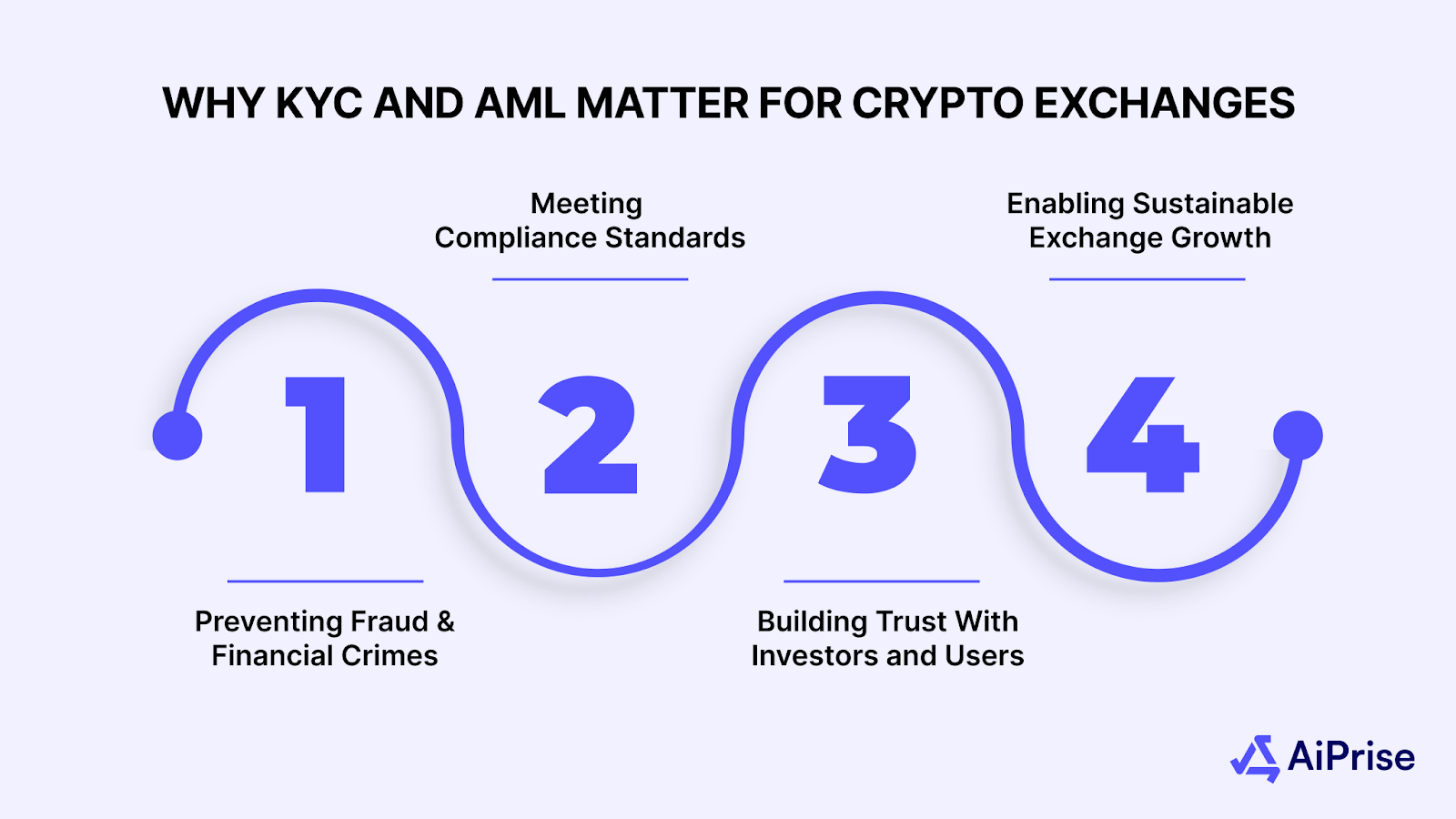
Crypto exchanges sit at the intersection of innovation and regulation. On one side, they offer speed, global access, and decentralization; on the other, they face constant scrutiny from regulators worldwide. Without strong KYC and AML frameworks, exchanges risk becoming gateways for financial crime.
Here’s why these processes are critical:
Preventing Fraud and Financial Crimes
- Stop money laundering, terrorist financing, and fraudulent schemes.
- Verify user identities to ensure only legitimate participants access the platform.
- Monitor transactions to detect unusual activity early.
- Protect the exchange’s reputation and financial stability.
Meeting Global and Regional Compliance Regulations
- Align with U.S. FinCEN, EU AML directives, and other global standards.
- Reduce risk of fines, penalties, and license suspensions.
- Adapt quickly to evolving laws across multiple jurisdictions.
- Ensure compliance consistency for international operations.
Building Trust With Investors and Users
- Demonstrate commitment to transparency and user protection.
- Reassure retail traders and institutional investors about platform safety.
- Encourage higher-value transactions by reducing fraud concerns.
- Strengthen the exchange’s credibility in competitive markets.
Enabling Sustainable Exchange Growth
- Support secure onboarding at scale.
- Reduce fraud-related costs that hinder expansion.
- Maintain regulatory approval for long-term operations.
- Provide a stable, trustworthy environment for global users.
Also Read: How Businesses Can Benefit from Free KYC Verification
To fully appreciate current compliance standards, it is helpful to look back at how KYC and AML practices have evolved in the cryptocurrency industry over time.
Historical Evolution of KYC and AML in Crypto
Crypto exchanges operate at the intersection of innovation and regulation. From early anonymous transactions to today’s FATF Travel Rule and SEC/FinCEN oversight, KYC and AML have evolved. Strong compliance not only protects platforms from fines and reputational risks but also builds investor trust and supports sustainable growth.
Early Days: Anonymous Transactions and Minimal Regulation
- Bitcoin’s launch in 2009 enabled peer-to-peer transfers without identity checks.
- Early crypto exchanges focused on accessibility, not compliance.
- Limited awareness of money laundering risks in digital assets.
- Attracted both enthusiasts and bad actors due to anonymity.
Turning Point: Global Governments Tightening Crypto Regulations
- High-profile hacks and money laundering cases drew regulatory attention.
- Countries such as the U.S., Japan, and South Korea have introduced KYC mandates.
- Regulators began requiring exchanges to register as money services businesses.
- The goal shifted to striking a balance between innovation and preventing financial crime.
Current Landscape: AML Directives, FATF Travel Rule, SEC/FinCEN Oversight
- FATF’s Travel Rule requires exchanges to share sender/receiver data for transactions.
- The EU’s AML directives impose strict compliance and reporting obligations.
- U.S. oversight from the SEC, FinCEN, and CFTC continues to expand.
- Today, exchanges must operate with robust KYC and AML frameworks to stay compliant.
Now that we understand their importance and evolution, let’s break down the practical, step-by-step process of how exchanges implement KYC and AML.
Step-by-Step: How KYC and AML Work in Crypto Exchanges
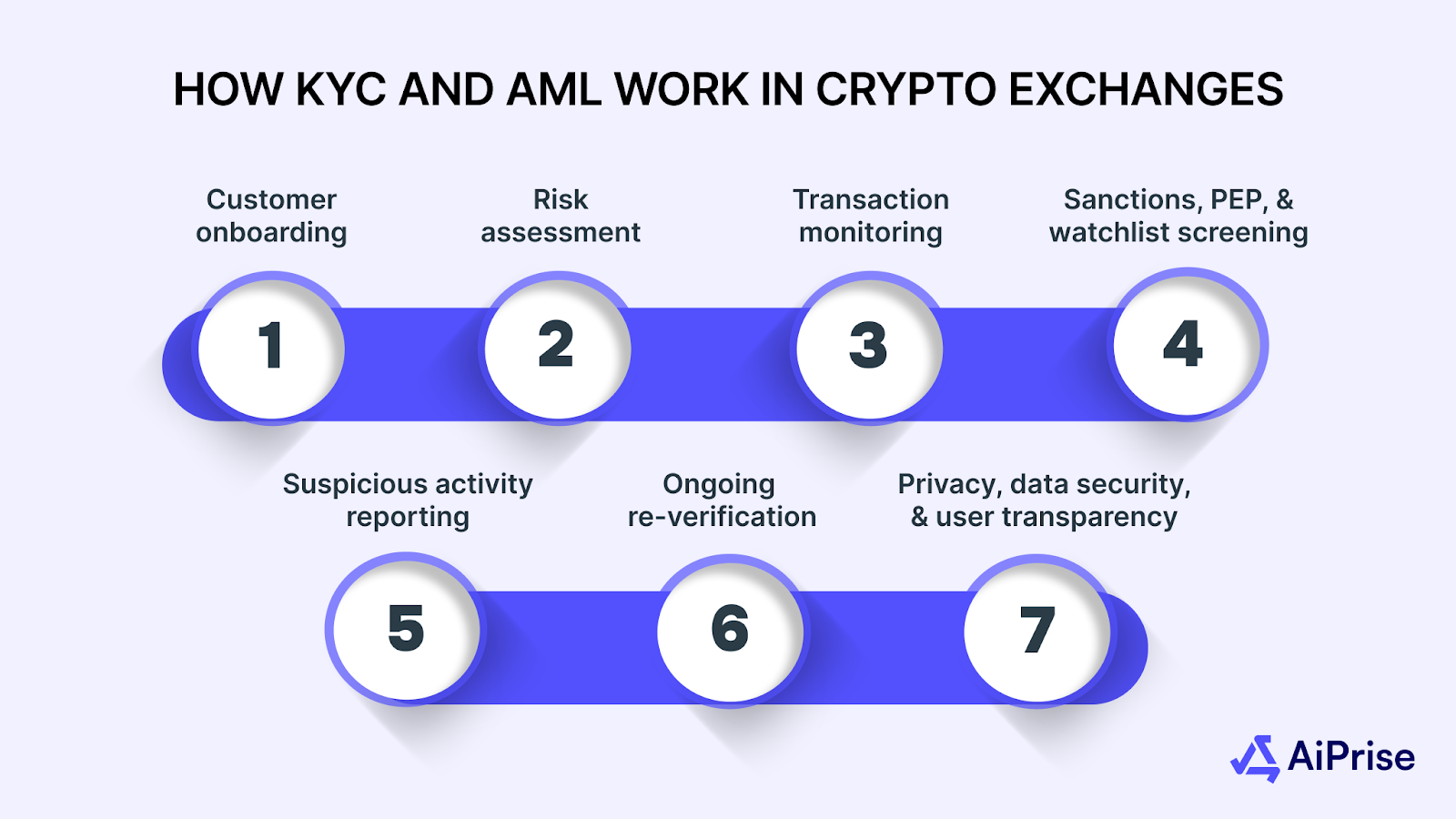
KYC and AML aren’t just regulatory requirements; they’re operational processes that directly impact security and risk management on crypto exchanges. From verifying identities to monitoring transactions and flagging suspicious activity, each step ensures compliance, reduces fraud, and safeguards user funds.
Below is a practical, stepwise breakdown of how exchanges typically run these processes from onboarding to ongoing monitoring.
Step 1: Customer onboarding and ID verification
- Collect basic personal data: full name, DOB, email, phone, and country of residence.
- Ask for government-issued photo ID and proof of address.
- IDs usually required: passport, national ID, driver’s license; utility bill or bank statement for address.
- For corporate accounts, collect incorporation docs, ownership structure, and UBO (ultimate beneficial owner) details.
- Verify documents with OCR and data extraction to reduce manual entry.
- Perform a selfie-based liveness check to verify the user's identity against the ID photo.
- Capture user consent and display a privacy notice explaining data use and retention.
- Encrypt data in transit and at rest; limit access with role-based controls.
Step 2: Risk assessment and customer profiling
- Assign an initial risk score based on country, transaction intent, and customer type.
- Apply a tiered verification model: lighter checks for low-risk, enhanced checks for high-risk.
- Collect source-of-funds and source-of-wealth information for higher-risk customers.
- Set transaction and withdrawal limits tied to risk tiers.
- Escalate suspicious or high-value accounts to enhanced due diligence (EDD).
Step 3: Transaction monitoring and anomaly detection
- Monitor fiat on/off ramps and on-chain wallet activity in real time.
- Run velocity checks, unusual volume alerts, and pattern-detection rules.
- Use on-chain analytics to cluster wallets, track mixers, and flag suspicious flows.
- Apply machine-learning models to score behavioral risk and reduce false positives.
- Route high-scoring alerts to compliance investigators for manual review.
Step 4: Sanctions, PEP, and watchlist screening
- Screen customers against OFAC, UN, EU, FATF-style lists, and local watchlists.
- Continuously refresh sanctions and PEP lists and re-screen existing customers.
- Use fuzzy matching and aliases to catch name variations and transliterations.
- Screen wallet addresses and related entities, not just user names.
Step 5: Suspicious activity reporting and case management
- Triage alerts into investigated cases with evidence logs and analyst notes.
- File Suspicious Activity Reports (SARs) to appropriate authorities when required.
- Keep a complete audit trail for each case: timestamps, documents, screening results, decisions.
- Maintain escalation rules and SLAs for compliance review and reporting.
Step 6: Ongoing re-verification and lifecycle management
- Trigger periodic KYC refreshes based on risk level or time-based schedules.
- Re-verify after key events: large withdrawals, changes in ownership, or travel-rule transfers.
- Retain records per jurisdictional rules (commonly 5–7 years) and make them audit-ready.
- Deprovision or restrict accounts with unresolved verification failures.
Step 7: Privacy, data security, and user transparency (cross-cutting)
- Minimize data collection to what’s legally required and relevant to risk.
- Publish a clear data retention and deletion policy for users.
- Conduct regular security audits and penetration tests.
- Provide users with clear communication on verification status and next steps.
Even with a structured process in place, crypto exchanges encounter numerous hurdles that complicate KYC and AML compliance.
Challenges Crypto Exchanges Face With KYC and AML
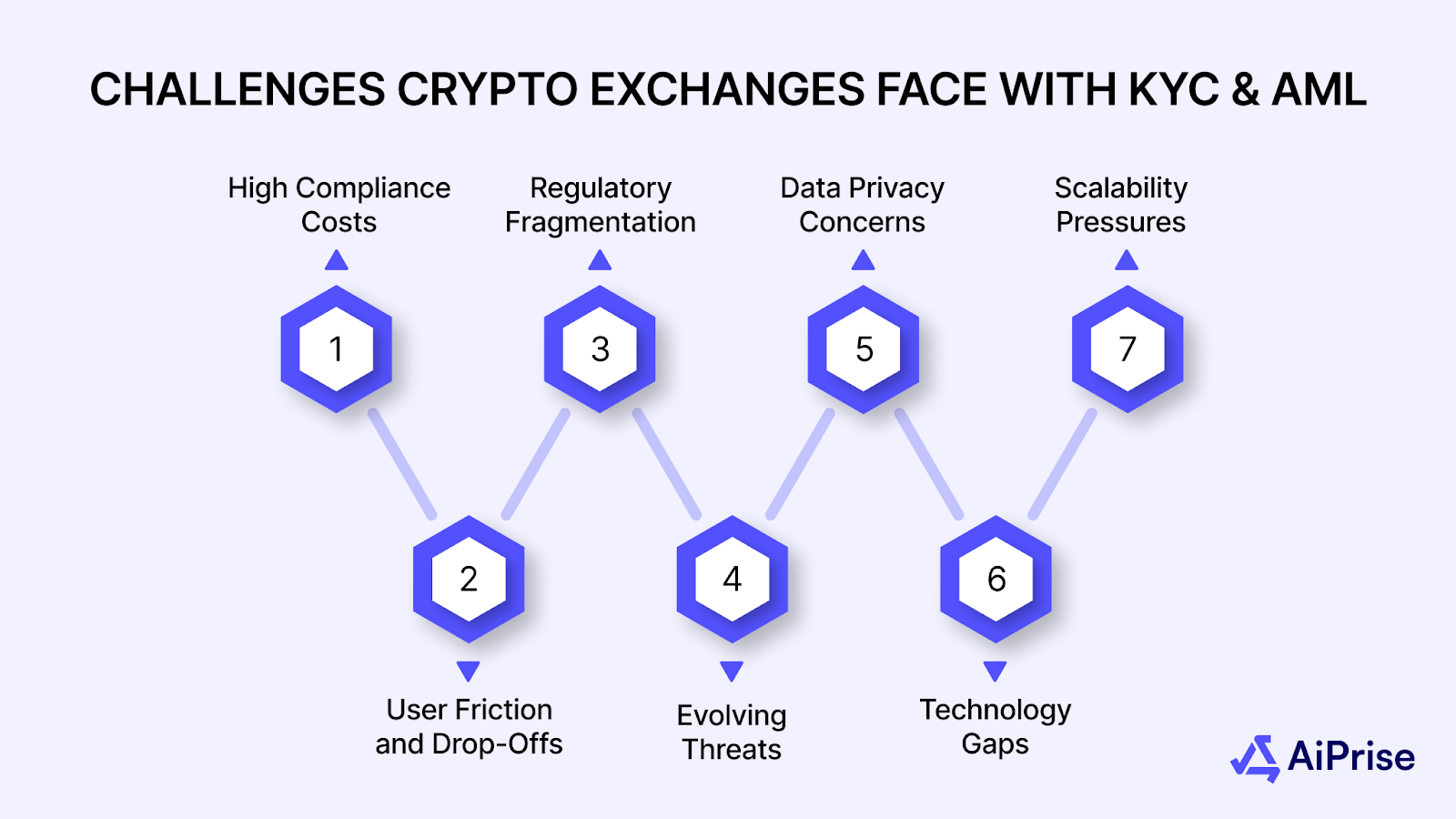
KYC and AML compliance in crypto exchanges is essential, but it comes with several operational, regulatory, and user-experience hurdles.
Let’s break them down for clarity:
- High Compliance Costs: Implementing verification systems, hiring compliance staff, and integrating on-chain analytics tools add significant expenses, especially for smaller exchanges.
- User Friction and Drop-Offs: Long verification processes and repeated document requests often frustrate users, leading to higher abandonment rates during onboarding.
- Regulatory Fragmentation: Global exchanges must deal with inconsistent rules across jurisdictions, making it challenging to apply a uniform compliance strategy.
- Evolving Threats: Crypto-specific risks, including mixers, privacy coins, and cross-chain bridges, continually challenge AML detection models.
- Data Privacy Concerns: Handling sensitive user data across multiple geographies introduces risks related to storage, security, and compliance with laws such as the GDPR.
- Technology Gaps: Legacy systems or underdeveloped infrastructures make it harder for exchanges to integrate automated monitoring, sanctions screening, and reporting tools.
- Scalability Pressures: Rapid spikes in user sign-ups or trading activity can overwhelm manual KYC processes, leading to bottlenecks and compliance gaps.
Also Read: Understanding the Differences and Relationship Between KYC and CDD
Emerging technologies, such as AI and automation, are helping exchanges overcome these challenges, making compliance faster, more innovative, and more efficient.
How AI and Automation Improve KYC/AML in Crypto
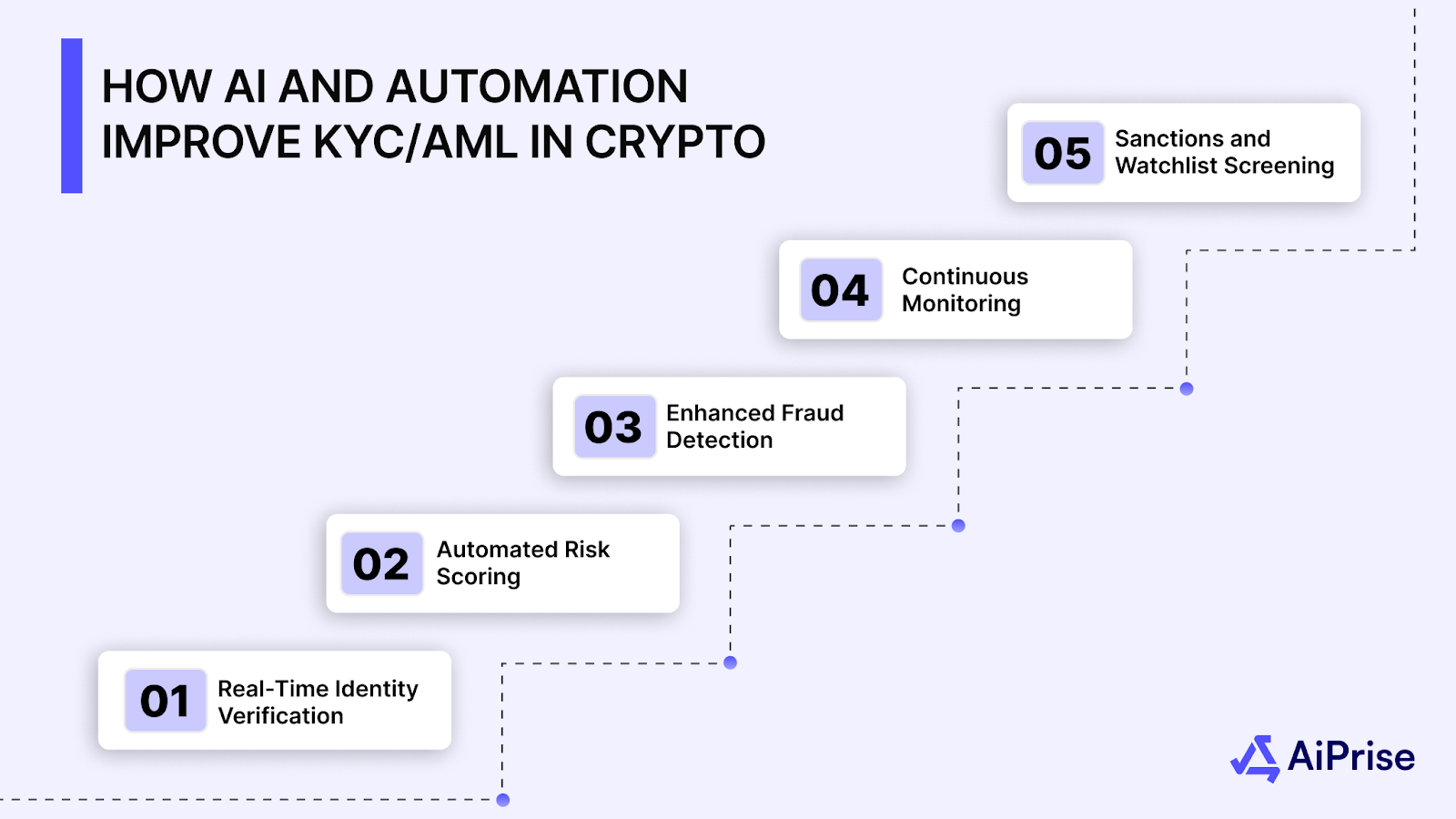
AI and automation are transforming how crypto exchanges handle KYC and AML compliance. By streamlining verification, risk detection, and monitoring, these technologies reduce manual workload, speed up onboarding, and enhance accuracy.
Let’s break down the key improvements they bring:
- Real-Time Identity Verification: AI-powered OCR and facial recognition instantly validate IDs and selfies, reducing onboarding time and user frustration.
- Automated Risk Scoring: Machine learning models analyze transaction patterns, wallet histories, and behavioral signals to assign dynamic risk scores for each user.
- Enhanced Fraud Detection: AI identifies anomalies such as synthetic identities, mixer usage, or unusual transfer patterns that traditional methods might miss.
- Continuous Monitoring: Automated systems track transactions and wallet activity 24/7, flagging suspicious behavior and triggering alerts for manual review only when necessary.
- Sanctions and Watchlist Screening: AI updates and cross-references global sanctions, PEPs, and adverse media lists in real-time, ensuring ongoing regulatory compliance.
For crypto platforms seeking a comprehensive solution, AiPrise provides a robust platform that streamlines KYC and AML compliance while enhancing the user experience.
How AiPrise Helps Crypto Exchanges
Managing KYC and AML compliance in crypto can be complex, but AiPrise provides a comprehensive platform that simplifies the process while enhancing accuracy and speed.
Here’s how AiPrise supports crypto exchanges:
- Global Coverage: Verify users across 220+ countries with support for passports, government-issued IDs, and driver’s licenses.
- Instant Identity Validation: Match ID documents and selfies against trusted government databases in real time for faster onboarding.
- Proof of Address Verification: Confirm user addresses quickly and reliably using verified data sources to strengthen compliance checks.
- Automated AML Screening: Continuously monitor users against sanctions lists, PEPs, and adverse media, ensuring ongoing regulatory adherence.
- Fraud Prevention: Detect synthetic identities, deepfakes, and high-risk profiles using AI-powered checks to mitigate financial crime.
- Case Management & Workflow Automation: Centralize flagged cases for efficient investigation, reduce manual effort, and streamline vendor management.
- Customizable Compliance Frameworks: Tailor workflows and risk scoring to your exchange’s specific regulatory obligations and business needs.
- Scalable Monitoring: Handle high volumes of transactions and user growth without compromising verification quality or compliance standards.
By combining AI-driven identity verification, AML monitoring, and fraud detection in a single platform, AiPrise enables crypto exchanges to operate securely, stay compliant, and provide a smooth onboarding experience for users.
Conclusion
Effective KYC and AML compliance requires strategic planning, appropriate technology investment, and ongoing operational commitment. Exchanges that implement comprehensive compliance frameworks early gain competitive advantages through enhanced credibility, broader market access, and reduced regulatory risk.
Success depends on understanding specific regulatory requirements, choosing scalable technology solutions, and maintaining operational excellence as business volumes grow. Consider partnering with established compliance providers like AiPrise to utilize proven solutions and accelerate your path to regulatory compliance.
Ready to strengthen your crypto exchange’s compliance while simplifying onboarding and fraud prevention? Book A Demo with AiPrise today to see how our platform can help you automate complex workflows, reduce operational friction, and stay ahead of regulatory demands.
FAQs
1. What is the KYC process for crypto exchanges?
The KYC process verifies a user’s identity using government-issued IDs, selfies, and proof of address. It ensures only legitimate users access the platform while preventing fraud and financial crime. By following KYC, exchanges comply with regional and global regulations, building trust with both regulators and investors.
2. Why is AML important for crypto exchanges?
AML practices help exchanges detect and report suspicious activities that may involve illicit funds. By implementing strong AML controls, platforms reduce exposure to fraud, money laundering, and terrorist financing. This safeguards the exchange's reputation and long-term sustainability.
3. Are KYC and AML required for all crypto users?
Yes, in most jurisdictions, KYC and AML checks are mandatory for all users, regardless of account type or transaction size. Regulators enforce these measures to ensure transparency and curb misuse of crypto platforms for unlawful activities. For users, this builds a safer, more reliable trading environment.
4. How does AI improve KYC and AML in crypto?
AI enhances compliance by automating ID verification, risk scoring, and real-time transaction monitoring. This reduces manual effort while speeding up customer onboarding and improving accuracy.
5. Can AiPrise help with global crypto compliance?
Yes, AiPrise offers solutions designed for multi-jurisdictional compliance, ensuring exchanges meet diverse regulatory standards worldwide. Its AI-driven platform automates AML monitoring, fraud detection, and identity verification.
You might want to read these...

Aiprise has helped streamline our KYB (Know Your Business) flow in 100+ countries. No other tool comes close.





Speed Up Your Compliance by 10x
Automate your compliance processes with AiPrise and focus on growing your business.






